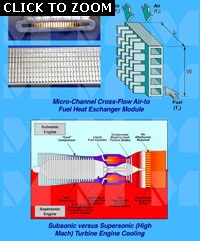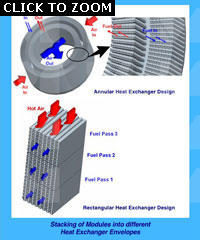Applications: Turbine Engine Cooling
 Supersonic gas turbine engines pose unique thermal management challenges not encountered in subsonic engines. In both cases, compressor bleed air is used to cool various downstream engine components such as turbine blades and afterburner walls. In subsonic engines, compressor bleed air is cool enough to be used directly for downstream cooling purposes. However, in supersonic engines, compressor bleed air temperature is quite high and therefore a heat exchanger is needed to precool the air before it can effectively cool the downstream engine components.
Supersonic gas turbine engines pose unique thermal management challenges not encountered in subsonic engines. In both cases, compressor bleed air is used to cool various downstream engine components such as turbine blades and afterburner walls. In subsonic engines, compressor bleed air is cool enough to be used directly for downstream cooling purposes. However, in supersonic engines, compressor bleed air temperature is quite high and therefore a heat exchanger is needed to precool the air before it can effectively cool the downstream engine components.
Compressor bleed air can be cooled by rejecting heat to either engine fan’s bypass air or fuel. In some cases, depending on engine cycle requirements and thermal management architecture, using fuel as heat sink may allow a more compact and lightweight heat exchanger design than using air.
 Mudawar’s team recently developed an air-fuel heat exchanger that is more compact, lightweight and thermally effective than current designs. The new heat exchanger is comprised of many small modules that can be integrated in different ways to suit a variety of engine envelopes. Within each module, fuel is routed through a series of parallel mini-channels formed in a thin monolithic metallic structure. Aside from highly compact and lightweight design, these modules greatly increase both heat transfer area to volume ratio and fuel-side heat transfer coefficient. The module design also enhances heat transfer on the airside with the aid of short rectangular fins. The fins are formed in rows and aligned with the airflow but perpendicular to the direction of fuel flow. The fins enhance airside heat transfer by greatly increasing heat transfer area. More importantly, by using a series of short fins as opposed to continuous fins, they produce large heat transfer coefficients by capitalizing on thin leading edges of multiple airside boundary layers.
Mudawar’s team recently developed an air-fuel heat exchanger that is more compact, lightweight and thermally effective than current designs. The new heat exchanger is comprised of many small modules that can be integrated in different ways to suit a variety of engine envelopes. Within each module, fuel is routed through a series of parallel mini-channels formed in a thin monolithic metallic structure. Aside from highly compact and lightweight design, these modules greatly increase both heat transfer area to volume ratio and fuel-side heat transfer coefficient. The module design also enhances heat transfer on the airside with the aid of short rectangular fins. The fins are formed in rows and aligned with the airflow but perpendicular to the direction of fuel flow. The fins enhance airside heat transfer by greatly increasing heat transfer area. More importantly, by using a series of short fins as opposed to continuous fins, they produce large heat transfer coefficients by capitalizing on thin leading edges of multiple airside boundary layers.
Another key advantage of the module design is allowing the air-fuel heat exchanger to be configured in variety of design envelopes, such as annular or rectangular, depending on volume, weight or packaging constraints set by the engine manufacturer.
